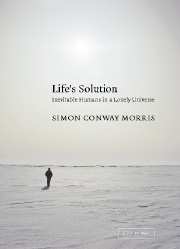Book contents
- Frontmatter
- Contents
- Preface. The Cambridge sandwich
- Acknowledgements
- List of abbreviations
- 1 Looking for Easter Island
- 2 Can we break the great code?
- 3 Universal goo: life as a cosmic principle?
- 4 The origin of life: straining the soup or our credulity?
- 5 Uniquely lucky? The strangeness of Earth
- 6 Converging on the extreme
- 7 Seeing convergence
- 8 Alien convergences?
- 9 The non-prevalence of humanoids?
- 10 Evolution bound: the ubiquity of convergence
- 11 Towards a theology of evolution
- 12 Last word
- Notes
- Index
6 - Converging on the extreme
Published online by Cambridge University Press: 07 September 2009
- Frontmatter
- Contents
- Preface. The Cambridge sandwich
- Acknowledgements
- List of abbreviations
- 1 Looking for Easter Island
- 2 Can we break the great code?
- 3 Universal goo: life as a cosmic principle?
- 4 The origin of life: straining the soup or our credulity?
- 5 Uniquely lucky? The strangeness of Earth
- 6 Converging on the extreme
- 7 Seeing convergence
- 8 Alien convergences?
- 9 The non-prevalence of humanoids?
- 10 Evolution bound: the ubiquity of convergence
- 11 Towards a theology of evolution
- 12 Last word
- Notes
- Index
Summary
One of the boasts of the physicist is that if she is standing on an Earth-like planet on another galaxy, then the apple she tosses to her male colleague will follow a trajectory whose course may be followed by precise equations. The biologist, however, could not even begin to address the probability of there being sexes, let alone hands and apples (not to mention serpents) on other worlds. That is certainly the widely accepted view: rewind the tape of life, as S. J. Gould repeatedly claimed, and let it replay: assuredly next time round the world will be a very different place, with a vanishingly small prospect of anything like a human emerging. I have already argued forcibly against such a position, and the purpose of much of the rest of this book is to develop in more detail why the trajectories of evolution are much more severely constrained than is sometimes supposed. Nevertheless, this is not the popular view. The present consensus is that, first, this world is only one of many similar ones, although as we have already seen (Chapter 5) such optimism is open to some doubt. Second, and more significantly, it is widely agreed that notwithstanding the unremitting processes of biological diversification even the most trivial differences in the starting conditions would have led to entirely different evolutionary histories, each with a radically different outcome. Nothing like a butterfly, a daisy, or a dolphin and certainly, as we are repeatedly informed, nothing like a human.
- Type
- Chapter
- Information
- Life's SolutionInevitable Humans in a Lonely Universe, pp. 106 - 146Publisher: Cambridge University PressPrint publication year: 2003

